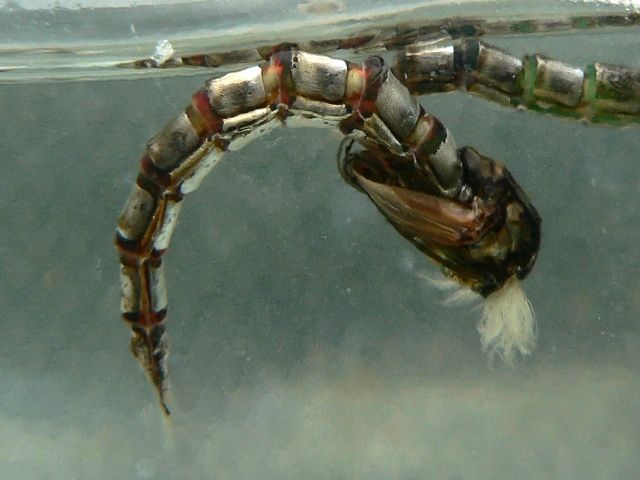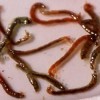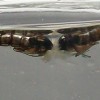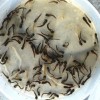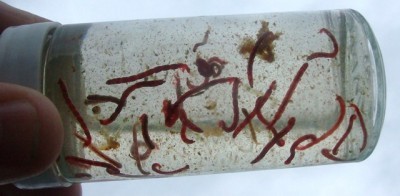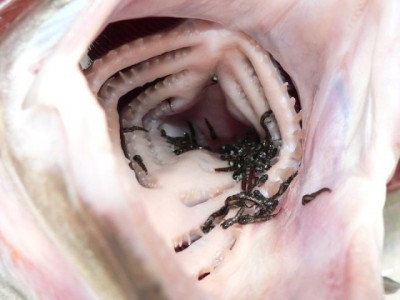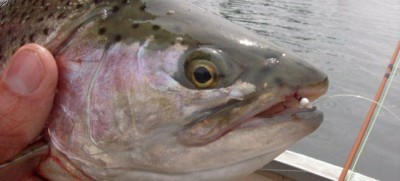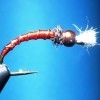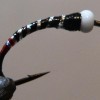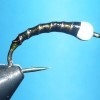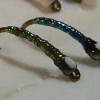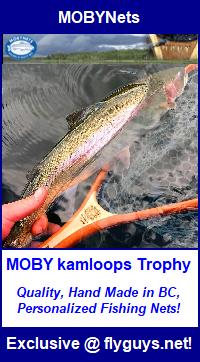Fly Fishing Chironomids
With regards to BC Interior lakes (small/medium), chironomids are generally the most abundant food source available to fish, and therefore an important insect to understand. Acquiring knowledge which can be applied to the various situations which an angler may encounter offers great rewards. Anglers are often daunted with how to apply the right technique at the right time and place. The purpose of this page is to help tie all the pieces together. If we could fish only one fly on the still water lakes of beautiful British Columbia it would be the chironomid!
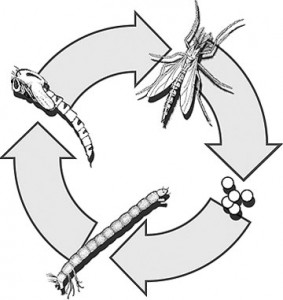 The chironomid has four different life stages; (1) the egg, 2) the larva (aka ‘bloodworm’), (3) the pupa, and (4) the mature adult (winged terrestrial). Of these 4 stages 3 are fishable, and therefore important to anglers. Chironomid Larve are important to anglers as they are available to trout at all times of the year. Chironomid Pupae, although present in large numbers only during hatches, may be labeled as the most important stage of life, as far as the angler is concerned, due to the fact that trout key in on them ferociously. Of least concern, although important when the trout decide to focus solely on them, is the mosquito like mature Chronomid Adult (winged terrestrial).
The chironomid has four different life stages; (1) the egg, 2) the larva (aka ‘bloodworm’), (3) the pupa, and (4) the mature adult (winged terrestrial). Of these 4 stages 3 are fishable, and therefore important to anglers. Chironomid Larve are important to anglers as they are available to trout at all times of the year. Chironomid Pupae, although present in large numbers only during hatches, may be labeled as the most important stage of life, as far as the angler is concerned, due to the fact that trout key in on them ferociously. Of least concern, although important when the trout decide to focus solely on them, is the mosquito like mature Chronomid Adult (winged terrestrial).
Fly Fishing Chironomids | Larvae …….
The majority of chironomid larvae live in tubes in the mud from 6 to 25ft and deeper. They are vulnerable to trout predation when migrating and when, in large numbers, they come out of their tubes to eat and relocate to bigger tubes. In the spring they migrate towards the shallows and then in the fall they head back to deep water.
They move along slowly, crawling on or swimming, near the bottom among the mud and weeds. During wind generated currents in the spring and fall, large numbers of larva can be swept up to the surface where they are then fed upon by trout.
Although typically a one year cycle, some species exist in the larval stage for up to 2 years before transforming into the pupa.
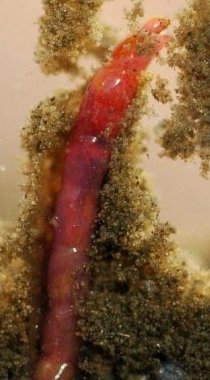 When to Fish Chironomid Larvae …
When to Fish Chironomid Larvae …
Fly fishing chironomids larva can be successful year round but fishing is best in the spring (just after ice off to early summer), and again in the late fall (just prior to ice up).
They can also be effective as a searching pattern when there is little other activity on the surface.
As mentioned above, trout will key in on chironomid larvae as they become vulnerable when caught up in wind mixed water … an event which can be quite exciting as the fishing can be excellent! Half the battle is in recognizing that you are in this situation so keep your eyes open whenever encountering windy days on the water. 😉
Fly Fishing Chironomids | Pupae …….
The pupa stage of the chironomid life cycle is relatively short. Chironomids emerge as pupa from their mud tubes on the lake bottom. At this point, and usually in large numbers, the pupa begins its ascent to the surface. With their bodies in a vertical position , they slowly wiggle to the surface becoming very vulnerable to trout predation.
Once at the surface they begin to break free of their pupal casing and crawl vertically from the husk leaving it laying horizontal in the water.
When to Fish Chironomid Pupae …….
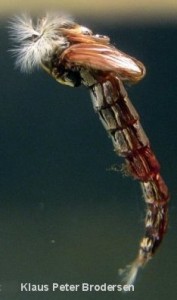 Like the larva, fly fishing chironomids pupa can be successful year round but is best in the spring (just after ice off to early summer) and again in late fall. They can be very successful during a hatch and whenever casings are present on surface of the water.
Like the larva, fly fishing chironomids pupa can be successful year round but is best in the spring (just after ice off to early summer) and again in late fall. They can be very successful during a hatch and whenever casings are present on surface of the water.
… but don’t rule out late summer … check out Bomber Chironomids – the Exception to the Rule by John Kent!
Trout key on the pupa during its slow wiggling ascent to the surface. Another indication of pupa ascent is feeding birds as well as swarms of flies hovering near shore – a clue to a recent hatch.
Fly Line & Presentation for Fly Fishing Chironomids (larva & pupa) …….
Floating Line – A floating line with long leader/tippet is very effective in water up to 10ft. deep. Use either sinking tippet, sinking dressing or a weighted fly to present quickly. Tippet sizes from 4x – 6x are common.
Attach enough tippet material to reach the lake bottom. Place a strike indicator on the tippet to keep the fly suspended near or just on the bottom and keep a careful eye on it.
Use a VERY slow, one inch per second and slower, retrieve. You will be able to detect bottom as the indicator will bob under slightly when retrieved as the fly hooks on weeds.
When a fish takes the fly, the indicator may suddenly dart under the surface or the take may be so subtle that the indicator barley tips over in the water – either way, at this time the fly must be set quickly or you may miss the fish.
To use floating line with no strike indicator let the fly settle to near or on the bottom and slowly retrieve. Keep the line tight and watch end of the floating line for ANY movement. As with the indicator, set quickly upon the movement or you may miss the fish.
… for more detail on this deadly made in BC technique check out … long lining chironomids by Mr. Rainbow!
Sinking Line – Use sinking lines for water over 10 ft. A leader/tippet combo of 6 – 9 ft is fine as are tippet sizes from 4x – 6x.
After your cast simply let the fly settle to the bottom then s-l-o-w-l-y retrieve – one inch per second and slower but throw in the odd quick one to two inch jerk every thirty or so seconds …
If sight fishing, cast your fly in the area of the fish, being careful not to spook them, and then be patient until the fish are near your fly – at this point begin a slow retrieve.
… for more detail on the sinking line style check out … deep water chironomids by John Sclar!
These techniques are just starting points … vary it up until you find what is working on that particular day. Don’t give up cause when you hit the sweet spot you will be in for some of the best fly fishing that you will ever encounter!
Fly Fishing Chironomids | Adults (Terrestrial) …….
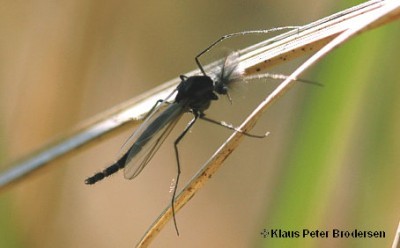 Chironomid adults look just like mosquitoes but without the bite. Fish adult chironomids when you see fish taking hatching pupae on the surface. A floating line is required and the presentation is usually very static. A light weight mono leader and tippet is a must to keep the presentation above board. Strikes are more noticeable than the underwater methods as you can literally see the fish sip the fly … this is the time to set the hook.
Chironomid adults look just like mosquitoes but without the bite. Fish adult chironomids when you see fish taking hatching pupae on the surface. A floating line is required and the presentation is usually very static. A light weight mono leader and tippet is a must to keep the presentation above board. Strikes are more noticeable than the underwater methods as you can literally see the fish sip the fly … this is the time to set the hook.
… check out this incredible underwater video depicting the life stages, natural movements & emergence of the chironomid (larva, pupa & adult) … generously permitted for our our use by Klaus Peter Brodersen!
Fly Fishing Chironomids | Fly Patterns …….
Larvae : Krazy, Graham or Kamloops Bloodworm, Sizes 10 to16, in red, green or a red/green combo. Commercial Patterns Include: Red Quill, Carey Red. Other Colors Include: Burgundy, Yellow, Tan & Clear
Pupae : Any of our pupa patterns from size 10 to 16 in black, brown, red, green and silver. Commercial Patterns Include: Doc Spratley, Lady McConnell (emerger). Other Colors Include: Tan, Gray and Clear
Adult : Griffiths Gnat, Brian Chan’s Lady McConnell & small Tom Thumbs.
* … there is typically a downsizing between chironomid life stages; larvae are larger than pupae which in turn are larger than adults, a key consideration when choosing patterns during an emergence. 😉
Fly Fishing Chironomids | Putting it all Together …
Fly Fishing Chironomids | Fly Pattern Photos:
Fly Fishing Chironomids | Tying Posts:
- 10 Proven BC Still Water Fly Patterns
- Bare Bones Chironamo Chironomid Fly Pattern
- Black & Silver Red Butt Chironomid Fly
- Bleeding Limey Chironomid Pupa Fly
- Blood Clot Bloodworm Chironomid Larvae Fly
- Chartreaus & Red ASB Chironomid Pupa Fly
- Chironomid Religion | The Church Window Chironomid
- Create A Hatch Chironomid Pupa Fly
- Hot Spot Chironomid Pupa Fly
- Iron Man Chromie Chironomid Fly Pattern
- John Kent – Hog Magnet Chironomid Pupa Fly Pattern
- John Kent Top Ten Chironomid Fly Patterns
- Kissing Chironomid Fly
- KKK Chironomid Pupa Fly
- Major General ASB Chironomid Fly
- Olive Shuttlecock Emerger Fly
- Pornomid Chironomid Pupa Fly Pattern
- Producer Chironomid Pupa Fly
- Screaming Viking | Green Red Butt Chironomid Pupa Fly
- Simple Thread Black & Red Chironomid Pupa Fly
- Wine & Gold Chironomid Pupa Fly
- Zebra Chironomid Pupa Fly
- Zucchini Chironomid Fly

